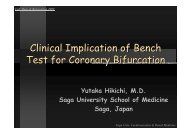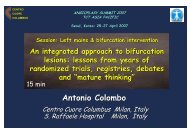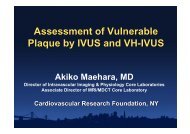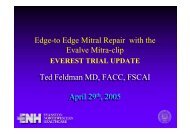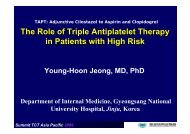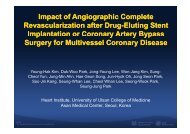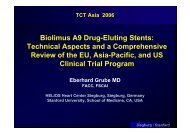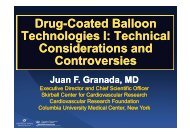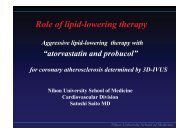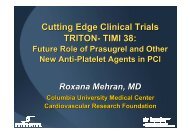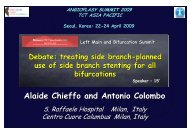Alcohol Septal Ablation for Hypertrophic ... - summitMD.com
Alcohol Septal Ablation for Hypertrophic ... - summitMD.com
Alcohol Septal Ablation for Hypertrophic ... - summitMD.com
Create successful ePaper yourself
Turn your PDF publications into a flip-book with our unique Google optimized e-Paper software.
<strong>Alcohol</strong> <strong>Septal</strong> <strong>Ablation</strong> <strong>for</strong><br />
<strong>Hypertrophic</strong> Obstructive<br />
Cardiomyopathy<br />
CardioVascular Research Foundation
<strong>Alcohol</strong> <strong>Septal</strong> <strong>Ablation</strong> (ASA)<br />
• Nonsurgical technique <strong>for</strong> septal myocardial reduction<br />
• Dramatic hemodynamic improvement<br />
• Technically easy to interventional cardiologists<br />
ASA therapy has been increasingly used <strong>for</strong> patients<br />
with HOCM unresponsive to medical treatment (until now,<br />
~3,500 cases worldwide).<br />
CardioVascular Research Foundation
Limitations of AST<br />
• Potential serious <strong>com</strong>plications:<br />
- a large infarct<br />
- <strong>com</strong>plete AV block<br />
- ventricular tachyarrhythmia<br />
• Hemodynamic recurrence<br />
CardioVascular Research Foundation
Hemodynamic Recurrence<br />
PG or LVEDP ( mmHg )<br />
160<br />
140<br />
120<br />
100<br />
80<br />
60<br />
40<br />
20<br />
0<br />
*<br />
*<br />
Resting PG of LVOT<br />
Provocable PG of LVOT<br />
LVEDP<br />
* P < 0.05<br />
N = 20<br />
Baseline Immediate 3 months<br />
SJ Park et al. Am J Cardiol 1999:83:1220-3<br />
CardioVascular Research Foundation
Purpose<br />
• To investigate the incidence and determinants<br />
of hemodynamic recurrence after successful<br />
ASA therapy<br />
• To investigate the impact of ethanol dose on<br />
hemodynamic recurrence and clinical<br />
out<strong>com</strong>es<br />
CardioVascular Research Foundation
Indications<br />
• Symptomatic patients (≥NYHA FC II) with<br />
HOCM unresponsive to medical therapy<br />
• Significant LVOT obstruction: resting > 30mmHg<br />
or provocable > 50mmHg<br />
• Basal septal thickness > 15mm<br />
CardioVascular Research Foundation
Study Patients<br />
Between December 1996 & March 2004,<br />
37 patients (20 females, 17 males) with<br />
symptomatic HOCM<br />
CardioVascular Research Foundation
Procedure of ASA<br />
Target Artery Balloon No Reflow<br />
Absolute alcohol (usually 2-3ml) was slowly injected through the lumen of the<br />
inflated balloon into the septal artery & left <strong>for</strong> 5 minutes be<strong>for</strong>e the balloon is<br />
deflated.<br />
CardioVascular Research Foundation
Myocardial Contrast<br />
Echocardiography (MCE)<br />
MCE was used to select the target artery,<br />
which supply the septal myocardium to be ablated.<br />
CardioVascular Research Foundation
Pressure Recording<br />
Be<strong>for</strong>e <strong>Ablation</strong><br />
After <strong>Ablation</strong><br />
CardioVascular Research Foundation
Post-ablation Management<br />
• Patients were observed in the intensive care unit<br />
<strong>for</strong> 1-3 days.<br />
• ECG and cardiac enzymes were carefully<br />
monitored.<br />
• Discharge : usually 7 days after the ASA<br />
CardioVascular Research Foundation
Procedure Summary<br />
• Target artery:<br />
1 st septal branch; 31 (80%)<br />
2 nd septal branch; 6 (15%)<br />
>1 septal branches; 3 (8%)<br />
• <strong>Alcohol</strong> amount: 3.7 ± 2.1ml (1~10)<br />
• Use of MCE: last 16 cases (43%)<br />
CardioVascular Research Foundation
Follow Up<br />
• Clinical follow-up every 3 months<br />
• Echocardiographic follow-up<br />
be<strong>for</strong>e discharge, 3-6 months and 1 year<br />
after the procedure, and thereafter when<br />
clinically indicated<br />
CardioVascular Research Foundation
Therapeutic Effects<br />
• Procedural success (relief of symptoms and<br />
reduction of LVOT pressure gradient >50%<br />
of baseline at Cath. Lab): 35 patients of 37<br />
patients who received AST (95%)<br />
• Symptomatic improvements(NYHA FC≥<br />
grade 1): 31 patients of 35 patients with<br />
procedural success (88%)<br />
CardioVascular Research Foundation
Echocardiographic Data<br />
Baseline<br />
Imme. postprocedure<br />
3 months after<br />
procedure<br />
1 year after<br />
procedure<br />
LVESD (mm)<br />
23.3 ± 5.6<br />
23.4 ± 4.7<br />
25.9 ± 5.3*<br />
26.5 ± 5.6*<br />
LVEDD (mm)<br />
41.7 ± 7.5<br />
41.9 ± 6.4<br />
45.1 ± 6.8*<br />
45.3 ± 6.5*<br />
IVS (mm)<br />
22.0 ± 5.0<br />
21.7 ± 4.8<br />
18.6 ± 4.4*<br />
18.4 ± 4.9*<br />
LVPW (mm)<br />
12.7 ± 2.3<br />
12.4 ± 1.9<br />
11.9 ± 2.5<br />
11.9 ± 2.4<br />
LA (mm)<br />
47.0 ± 7.4<br />
44.9 ± 6.1<br />
46.6 ± 8.2<br />
47.2 ± 7.5<br />
LVOT PG<br />
(mmHg)<br />
88.1 ± 45.8<br />
55.3± 40.9*<br />
42.1 ± 49.0*<br />
48.2 ± 40.3*<br />
*p
Evolution of LVOT PG<br />
Doppler echocardiogram<br />
LVOT pressure gradient (mmHg)<br />
90 88<br />
80<br />
70<br />
60<br />
50<br />
40<br />
30<br />
20<br />
10<br />
0<br />
5<br />
5 4<br />
4 8<br />
2<br />
Baseline Immedi. 3M 1Y 2Y<br />
4<br />
7<br />
CardioVascular Research Foundation
Hemodynamic Recurrence<br />
Number of patients<br />
9<br />
8<br />
7<br />
6<br />
5<br />
4<br />
3<br />
2<br />
1<br />
0<br />
9<br />
3<br />
2<br />
In hospital 6 M 1 year<br />
Definition:<br />
defined as re-elevation of<br />
LVOT pressure gradient ≥50%<br />
of baseline after successful<br />
procedure<br />
Of 35 patients with successful<br />
procedure, 14 patients (40%)<br />
had recurrence of LVOT<br />
obstruction.<br />
CardioVascular Research Foundation
Determinants of Hemodynamic<br />
Recurrence<br />
Recurrence<br />
(n=14)<br />
F/U duration (month) 56.5±30.3<br />
Age (year)<br />
52.8±11.2<br />
NYHA Class, initial 2.6±0.8<br />
NYHA Class, F/U 1.2±0.6<br />
MCE, n(%)<br />
8(57.1%)<br />
No Recurrence<br />
(n=21)<br />
62.5±30.2<br />
46.6±9.1<br />
2.1±0.9<br />
0.7±0.8<br />
7(33.3%)<br />
p-Value<br />
NS<br />
NS<br />
NS<br />
NS<br />
NS<br />
CardioVascular Research Foundation
Determinants of Hemodynamic<br />
Recurrence<br />
Recurrence<br />
No Recurrence<br />
p-Value<br />
<strong>Alcohol</strong> (ml)<br />
(n=14)<br />
3.1±2.0<br />
(n=21)<br />
4.2±2.2<br />
NS<br />
Peak CK (U/L)<br />
949±429<br />
2125±1510<br />
Recurrence of LVOT Obstruction<br />
Independent determinant of<br />
hemodynamic<br />
Recurrence of LVOT<br />
obstruction :<br />
CardioVascular Research Foundation<br />
Lower CK level (
Recurrence of LVOT Obstruction<br />
Sensitivity (%)<br />
100<br />
75<br />
50<br />
25<br />
0<br />
0<br />
25 50 75 100<br />
1 – specificity (%)<br />
For the prediction of<br />
hemodynamic<br />
recurrence<br />
CK< 1,100 U/L<br />
AUC:0.837<br />
sensitivity 85.7%<br />
specificity 81%<br />
positive predictive value 75%<br />
negative predictive value<br />
89.5%<br />
CardioVascular Research Foundation
Recurrence of LVOT Obstruction<br />
8000<br />
r=0.42, p
Early Complications<br />
• Death due to intractable VT: 1 (3%)<br />
• LAD infarct: 2 (5%)<br />
• CAVB: permanent 5 (14%), transient 18 (49%)<br />
CardioVascular Research Foundation
Predictors of Major Complications<br />
• Major <strong>com</strong>plications<br />
(cardiac death, LAD infarction,CAVB):<br />
- peak CK level > 2,000 U/L (50.0% vs. 22.2%, p
Long-term Follow up<br />
• Follow up duration : 20.6 ± 8.9 months<br />
• All cause death : 5 patients<br />
- Cardiac death 3 patients<br />
( peri-procedural death : 1 patients)<br />
- Non cardiac death 2 patients<br />
• Symptomatic improvement : 26/37 patients ( 70% )<br />
• Symptomatic ventricular tachycardia : 0 patients<br />
• Myocardial infarction : 3 patients<br />
CardioVascular Research Foundation
Survival Rate (%)<br />
Survival Curve<br />
100<br />
80<br />
60<br />
40<br />
20<br />
91.9 % 85.4 %<br />
0<br />
6 12 18 24 30 36<br />
Follow Up Duration ( Months )<br />
CardioVascular Research Foundation
Conclusions<br />
• AST is a promising nonsurgical technique <strong>for</strong> septal<br />
myocardial reduction in HOCM.<br />
• Major <strong>com</strong>plications was related to a large amount of<br />
alcohol injection (>4 ml), and hemodynamic recurrence<br />
was related to insufficient infarction.<br />
• Taken together, target artery and ethanol dose (2-3ml)<br />
should be carefully selected to get the therapeutic<br />
benefits without major <strong>com</strong>plications.<br />
CardioVascular Research Foundation
<strong>Hypertrophic</strong> Obstructive<br />
Cardiomyopathy<br />
• Left ventricular(LV) outflow obstruction<br />
is an important determinant of symptoms<br />
• Therapies that reduce the LV outflow<br />
pressure gradient may improve LV filling<br />
pressure and symptoms<br />
CardioVascular Research Foundation
Effect of LVOT<br />
on Clinical Out<strong>com</strong>e in HCMP<br />
Freedom from HCM-Related<br />
Death (%)<br />
No. at Risk<br />
100<br />
90<br />
80<br />
70<br />
60<br />
0<br />
P=0.001<br />
0 2 4 6 8 10<br />
Years after Gradient Measurement<br />
No obstruction<br />
Obstruction<br />
No obstruction<br />
828<br />
594<br />
495<br />
360<br />
247<br />
201<br />
obstruction<br />
273<br />
178<br />
130<br />
84<br />
54<br />
35<br />
CardioVascular Research Foundation<br />
NEJM 2003;348:295-3
Indication <strong>for</strong> ASA<br />
• Medically refractory symptoms<br />
• LV outflow pressure gradient:<br />
basal condition > 30 mmHg<br />
provocative maneuver > 50 mmHg<br />
CardioVascular Research Foundation
Myocardial Contrast<br />
Echocardiography<br />
CardioVascular Research Foundation
Myocardial Contrast<br />
Echocardiography<br />
MEC Risk Area (cm 2 )<br />
12<br />
10<br />
8<br />
6<br />
4<br />
2<br />
R=0.7<br />
N=23<br />
MCE can estimate<br />
the area of anticipated<br />
septal infarction and to<br />
prevent adverse<br />
out<strong>com</strong>e due to distal<br />
collaterals.<br />
0<br />
0 5 10 15 20 25 30 35<br />
SPECT Perfusion Defect (%)<br />
CardioVascular Research Foundation<br />
JACC 1998; 32 : 225-
Mean NYHA & CCS Class be<strong>for</strong>e<br />
and after <strong>Alcohol</strong> <strong>Septal</strong> <strong>Ablation</strong><br />
Mean Class (NYHA/CCS)<br />
3<br />
2.5<br />
2<br />
1.5<br />
1<br />
2.9<br />
1.9<br />
1.2<br />
NYHA<br />
CCS<br />
0.5<br />
0.4<br />
0<br />
Baseline<br />
NYHA (New York Heart Association class),<br />
CCS (Canadian Cardiovascular Society class)<br />
Follow-up<br />
12 months<br />
J Interv Cardiol 2006;19:319–327<br />
CardioVascular Research Foundation
Mean LVOT PG be<strong>for</strong>e and after ASA<br />
250<br />
225<br />
LVOTG (Provoked)<br />
LVOT gradient in mmHg<br />
200<br />
175<br />
150<br />
125<br />
100<br />
75<br />
50<br />
25<br />
0<br />
125.4<br />
65.3<br />
53.4<br />
42.4<br />
31.5<br />
17.1 16.3 15.8<br />
LVOTG (Rst)<br />
28.4<br />
15.1<br />
Baseline Post-ASA 3 months 12 months 24 months<br />
LVOT (Left ventricular outflow tract)<br />
J Interv Cardiol 2006;19:319–327<br />
CardioVascular Research Foundation
100<br />
LV Remodeling After ASA<br />
*<br />
*<br />
<strong>Septal</strong> mass<br />
Remote mass<br />
90<br />
*<br />
*<br />
80<br />
70<br />
1 month 6 months 1 month 6 months<br />
LV remodeling after ASA occurs early and progresses on midterm follow-up.<br />
Remote mass reduction is associated with infarct location & correlates with<br />
reduction of the LVOT PG.<br />
Circulation 2005; 111: 2503<br />
CardioVascular Research Foundation
Optimal Ethanol Amount<br />
90<br />
NS<br />
LVOG (mmHg)<br />
60<br />
30<br />
NS<br />
N=42<br />
Ethanol amount: >2ml vs ≤2ml<br />
NS<br />
NS<br />
NS<br />
0<br />
baseline postprocedural 3-5 days 3 weeks 3 months<br />
The early course of hemodynamic changes is not related<br />
to the use of a small or standard (>2 ml) dose of ethanol.<br />
Am J Cardiol 2005;95:675-8<br />
CardioVascular Research Foundation
<strong>Alcohol</strong> <strong>Septal</strong> <strong>Ablation</strong> vs<br />
Surgical <strong>Septal</strong> Myectomy<br />
ASA selectively<br />
produces transmural<br />
infarction of the<br />
basal mid-septum<br />
and adjacent right<br />
bundle tissue,<br />
whereas surgical<br />
myectomy affects the<br />
endocardial portion<br />
of the basal anterior<br />
septum and adjacent<br />
left bundle tissue.<br />
CardioVascular Research Foundation<br />
JACC2004;44:2329
Comparison of Surgical Myectomy vs ASA<br />
With Cardiac MRI in Patients with HOCM<br />
Myectomy<br />
ASA<br />
Myectomy<br />
ASA<br />
<strong>Septal</strong> myectomy provides consistent resection of the obstructing portion of the<br />
anterior basal septum, whereas the effect of ethanol septal ablation is more variable<br />
(more inferior location in basal & mid-ventricular septum; proximal basal septum<br />
spared in 25%).<br />
CardioVascular Research Foundation<br />
JACC2007;49:350
Complications (Systematic Review)<br />
N<br />
Mean±SEM<br />
Range<br />
In-hospital mortality (%)<br />
2,959<br />
1.5±0.03<br />
0.0-5.0<br />
Late mortality (%)<br />
2,840<br />
0.5±0.03<br />
0.0-9.3<br />
Complete AV block (%)<br />
1,869<br />
10.5±0.2<br />
0.0-40.0<br />
Ventricular fibrillation (%)<br />
464<br />
2.2±0.1<br />
0.0-4.0<br />
Persistence of symptoms (%)<br />
724<br />
10.8±0.2<br />
5.0-25.0<br />
J Interv Cardiol 2006;19:319–327<br />
CardioVascular Research Foundation
Need For Rigorous Studies<br />
• Potential <strong>com</strong>plications:<br />
<strong>com</strong>plete AV block, ventricular arrhythmia<br />
• At present, long-term follow-up is lacking.<br />
• Without a randomized study, it is difficult to<br />
assign efficacy differences between the<br />
ASA and surgical myectomy.<br />
CardioVascular Research Foundation
Summary<br />
• ASA is a promising nonsurgical technique<br />
<strong>for</strong> septal myocardial reduction in HOCM<br />
• A randomized trial <strong>com</strong>paring myectomy<br />
with ASA may be needed to assess the<br />
effectiveness of these therapies.<br />
CardioVascular Research Foundation



